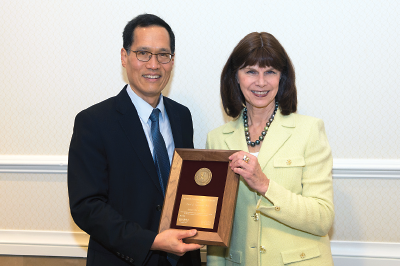Carol Tamminga, M.D., Recieves APA Research Award
Abstract
APA Director of Research Philip Wang, M.D., Dr.P.H., presents the APA Research Award to Carol Tamminga, M.D., last month at APA’s fall meeting, IPS: The Mental Health Services Conference, in Washington, D.C. The presentation was made during a session on early identification and treatment of psychosis.

Tamminga, who is the Lou and Ellen McGinley Distinguished Chair in Psychiatric Research at the University of Texas Southwestern Medical Center, published a paper earlier this year in AJP in Advance identifying three neurobiologically distinct psychosis “biotypes” that appear to cross clinical diagnostic boundaries for schizophrenia, schizoaffective disorder, and bipolar disorder with psychosis. She and colleagues recruited 800 patients, 1,000 of their family members, and 250 healthy controls to complete a battery of neurocognitive and perceptual tasks. They then characterized the participants according to biomarkers corresponding to cognition, auditory stimulation, brain electrical function as measured by electroencephalogram, and oculomotor movements, among other variables.
Using statistical analyses, Tamminga and colleagues identified three neurobiologically distinct subgroups of psychosis, each including patients representing all DSM psychosis categories.
“These data suggest that we have been grouping people in nonbiologically homogeneous groups up until now,” Tamminga told Psychiatric News at the time. “We anticipate that each of these biotypes will have a distinctive genetic profile; moreover, if these groups differ in their biological substrate, then unique medications ought to be available to treat each biotype.” ■



